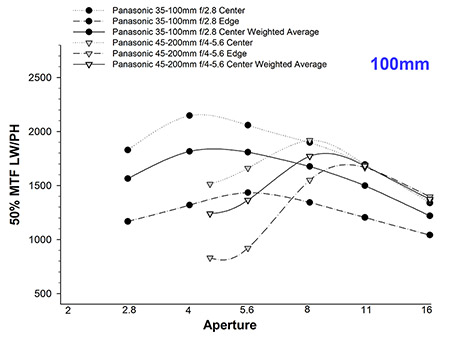Review of Panasonic Lumix GX Vario 35-100mm f/2.8 Lens
This review evaluates sharpness, bokeh and other photographic performance characteristics of the Panasonic Lumix GX Vario 35-100mm f/2.8 Lens for micro four thirds cameras. This is a constant aperture telephoto zoom lens that gives comparable perspective to that of a 70-200mm lens on a full frame DSLR camera. My interests were focused on using the lens for shooting candid photographs of people at events. MTF50 values were determined to assess sharpness and an indoor scene was photographed to evaluate out of focus background blurring characteristics of point light sources and reflected light (bokeh). I also compared bokeh performance of the lens with that of an Olympus 75mm f/1.8 lens and of a full frame DSLR camera and 70-200mm f/2.8 zoom.
 Panasonic G5 and 35-100mm Lens |
 Panasonic G5 and 35-100mm Lens with Canon 5D and EF 70-200mm f/2.8L lens |
|---|
MTF50 Results and Vignetting
MTF50 performance was determined using Imatest Master v. 3.7 and ISO-12233 resolution chart (QA-72 modification) using center and edge slanted edges to calculate center and edge MTF50. Data shown is the best of 3 replicate tests at each aperture. Center weighted MTF50 (60% center and 40% edge) was also plotted. Images were taken of a evenly illuminated light box at infinity focus at f/2.8, f/4 and f/5.6 at 35mm, 70mm and 100mm.
 35mm Compared to 14-45mm f/3.5-5.6 lens @ 35mm |
 75mm Compared to Olympus 75mm f/1.8 lens |
 100mm Compared to 45-200mm f/4-5.6 lens @ 100mm |
 Click image to see vignetting at 35, 70 and 100mm |
Chart images at 35mm, 75mm and 100mm (f/2.8-f/5.6)
35mm: f/2.8, f/4.0, f/5.6
75mm: f/2.8, f/4.0, f/5.6
100mm:
f/2.8, f/4.0, f/5.6
Bokeh Tests
Bokeh (or boke) is a photographic term originating from Japanese photographers that refers to quality of blur or fuzziness of out of focus areas due to lens design. A number of lens design characteristics influence the quality of out of focus blur (online references: Merklinger , van Walree , Atkins and Carl Zeiss) including aperture (both f/stop setting and maximal lens opening size), aperture iris shape, and degree of spherical aberration correction. Out of focus light blur qualities influencing whether out of focus blur or blur disc are perceived as pleasant or unpleasant are influenced by size of the blur disc, eveness of blur disc illumination and blur shape.
The lenses tested included the Panasonic 35-100mm f/2.8 @ 100mm and the Olympus 75mm f/1.8 lens with a Panasonic G5 camera and the Canon EF 70-200mm f/2.8L with a Canon EOS-5D Mark III.
The following images
to assess bokeh produced by the tested lenses were taken with out of focus backgrounds containing text as well as other objects with detail as well as point light sources and objects with specular (reflected) light. The lenses differed in the size and pattern of the point light sources in the out of focus background, the size and eveness of illumination of specular light in the background and overall blurring effect. As expected, the full frame DSLR lens 70-200 gave the most pleasing background blur at f/2.8. However, the Panasonic 35-100mm f/2.8 @ 100mm gave excellent blurring at f/2.8 and produced evenly illuminated out of focus blurred discs of specular light.
Sample Photographs
Summary of Results and Conclusions
Panasonic Lumix GX Vario 35-100mm f/2.8 Lens
Sharpness: Central image sharpness is good at the focal lengths tested. At 100mm, f/2.8, images are sharp enough in the center of the lens field for portrait purposes. Image edges at large aperture are soft. Image sharpness does not approach that of the Olympus 75mm f/1.8 lens.
Bokeh: At f/2.8 and f/4.0, the lens produces very good blurring of out of focus background that is attractive for candid portrait application. Bokeh quality produced by the 75mm f/1.8 lens and by the full frame 70-200mm f/2.8 lens are superior to that produced by the Panasonic 35-100mm f/2.8 lens.
Handling: The lens is light, compact and fast focusing. Mechanics of the zoom control are very smooth. The lens has the feel of the very expensive lens it is. The lens can be used with extension tubes in macro photography application.
Overall, this light weight, compact, high performance zoom is well worth the cost of purchase if you shoot candid event photos. I'm not sure I will be needing my Canon EOS system 70-200mm f/2.8L lens since this Panasonic 35-100mm lens will provide most of the photographic performance of the 70-200 at a fraction of the weight and size.
posted 12 November 2012.
© 2012, William L. Castleman



